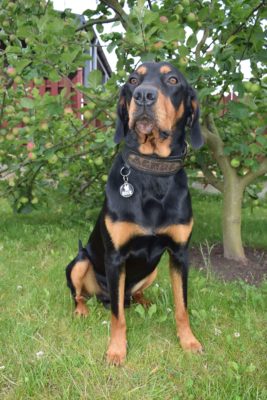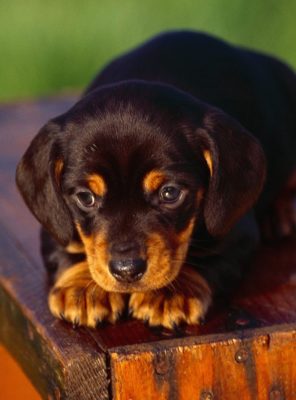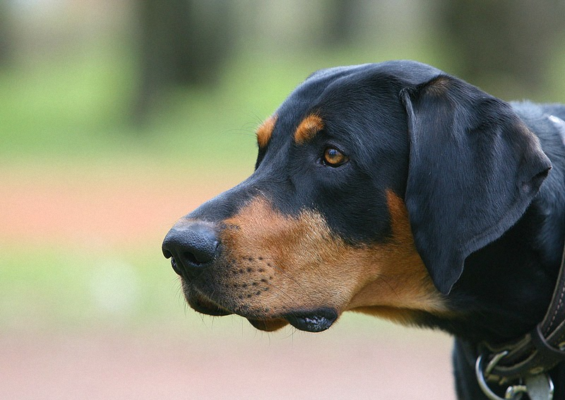Lithuanian Hound

The Lithuanian Hound is fully in character for its original function. It is designed for hunting, so it is purposeful and nimble. At the same time, it is adaptive. The animal becomes a good companion in the home and becomes attached to the owner. Early socialization makes them great babysitters. They quickly find contact with children. In general, with strangers, Lithuanian Hounds are quiet.
Table of Contents
Breed Information
| Another Name | Lietuvių skalikas |
| Origin | Lithuania |
| Height | Males 53-61 cm Females 48-55 cm |
| Weight | 27-32 kg |
| Fur | Short |
| Color | Black with scorch marks |
| Lifespan | 12-14 years |
| FCI Classification | Breeds outside the FCI classification |
| Group | Hunting Dogs |
| Price | From $350 |
Breed Photos
Origin History
Native dogs have been seen in Lithuania since the Ice Age. In the sixteenth century, the aristocrats of France instilled in Lithuania’s inhabitants a passion for hunting with hounds. Thus Lithuanian Hound dogs became an invariable attribute of successful hunting. Two centuries later, breeders decided to restore the breed of Courland Hounds. They were also popular among hunters in ancient times. Scientists for this purpose crossed Russian, Polish, and local hounds, the Bloodhound, and the Beagle. As a result, the Lithuanian Hound appeared, which became an ideal hunting companion. Representatives of the breed hunted wild boar, fox, rabbit, and other games. They were in good physical shape and were noted for their stamina.
The popularity of the first hares, as Lithuanian Hounds were also called, subsided after World War II. The breed was then threatened with extinction. Fortunately, the dog population resumed closer to the middle of the twentieth century. But in 1976, they reencountered difficulties. During the active hunting season, many representatives of Lithuanian Hounds were killed by wild boars. A year later, Lithuania created a cytological council, which worked to preserve the breed’s population. Today, Lithuanian Hounds are not particularly popular in the world. But in their homeland, Lithuania, their history remains stable. Officially, the breed is not recognized by Fédération Cynologique Internationale. But breeders don’t give up and work to make it happen.
Appearance
The dog is endowed with a muscular, large build with a powerful backbone. The body of the Lithuanian is not like other hounds: lighter bones and less weight. It helps to move faster and more actively. The wedge-shaped head with a straight muzzle. The teeth are straight with a scissor-like bite. The eyes are of a medium brown hue. Ears are triangular and fit tightly to the head. A broad and muscular back with a long tail downwards. The legs are straight with round paws.
The short coat is quite stiff, with luster. Slightly wavy hair is allowed on the back. Coloration is black with red undertones. There may be a white spot on the chest.
Character
The Lithuanian Hound is fully in character for its original function. It is designed for hunting, so it is purposeful and nimble. At the same time, it is adaptive. The animal becomes a good companion in the home and becomes attached to the owner. Early socialization makes them great babysitters. They quickly find contact with children. In general, with strangers, Lithuanian Hounds are quiet. But with active interaction can show aggression. By nature, dogs are endowed with vigilance and a keen sense of smell. At the first signs of insecurity, they immediately alert the owner. Because of this, they make excellent guards.
The Lithuanian Hound gets along with other dogs in a friendly way. Social skills have been promoted during hunting. But there are no guarantees about peaceful cohabitation with cats and other pets. By nature, the dog stalks anyone who in any way resembles prey.
Care
Brush your dog two to three times a week to maintain his natural shine. It will help leave the coat naturally smooth and soft. Seasonal shedding in Lithuanian Hounds occurs twice a year. After hunting, be sure to inspect the animal’s body for ticks and other insects. Regularly take care of the animal’s teeth, ears, and eyes. It is not necessary to bathe your pet often. Once for a couple of months is enough.
Training
The representatives of hunting dogs need intensive training like no other. They love to run in the woods and on the lawns. Animals lend themselves well to training. Unlike other hounds, they are diligent, obedient, and learn quickly. They are excellent at catching prey while also being able to resist excitement. Training can be done both within the confines of the aviary and home yard and in the field.
Common Diseases
Most of the breed is characterized by good health. They live an average of 12-14 years. Functional training, a balanced disposition, and good attitude help to keep in good health. Lithuanian Hounds are prone to:
- hip dysplasia;
- diseases of the kidneys, intestinal and gastrointestinal tract;
- eye diseases;
- cryptorchidism.
Nutrition
Animals are undemanding when it comes to food. But this does not negate the need for a balanced diet. Dogs love lean meat and by-products, vegetables, porridges, dairy products. It is worth limiting the consumption of potatoes and legumes. Completely exclude fatty, fried, salty, and spicy foods. Also, do not give your pet food from the human table. It’s not meant to be fed to dogs – gastrointestinal problems can set in. Because of the innate need for vigorous exercise, you don’t want to overfeed your pet. It is better to introduce a schedule where the dog eats at the same time.
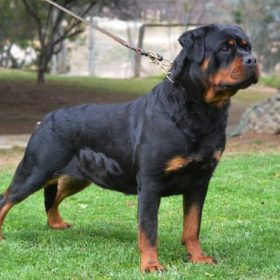 Rottweiler
Rottweiler Drever
Drever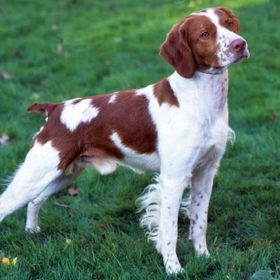 Brittany
Brittany Wirehaired Vizsla
Wirehaired Vizsla Saint Miguel Cattle Dog
Saint Miguel Cattle Dog Shikoku
Shikoku